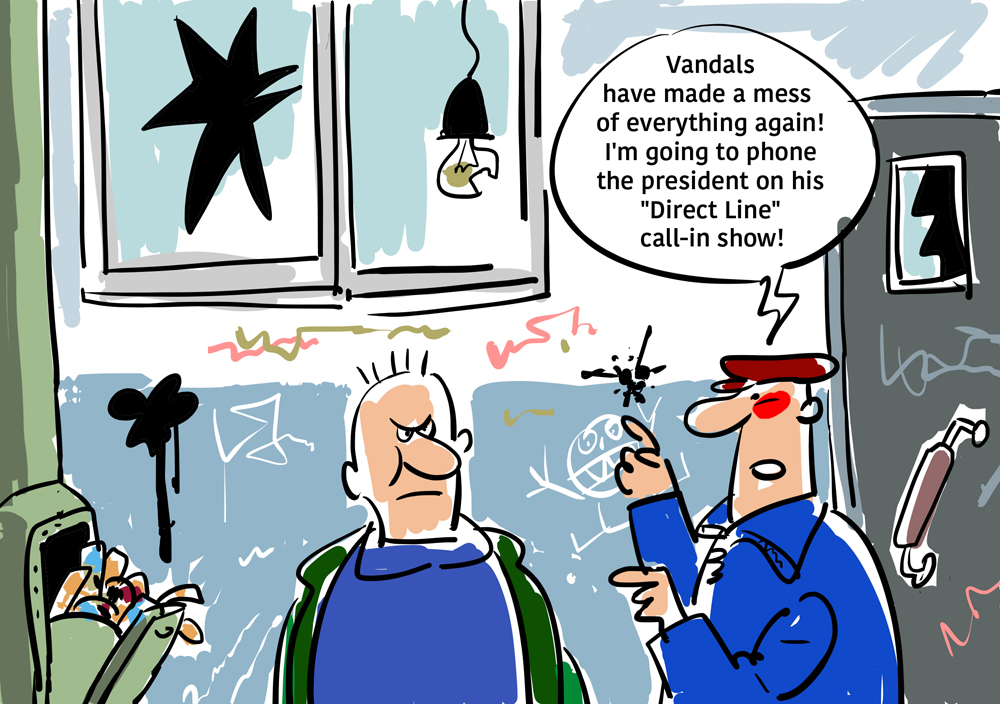
Drawing by Iorsh
Critics of Russian President Vladimir Putin often accuse him of creating a system of micromanaging the country. As a result, without his involvement it is impossible to repair a road or to find new housing for residents of a dilapidated apartment block in a town some 4,000 miles from Moscow.
According to them, it is this that makes the head of state’s regular TV phone-ins with the nation so popular. Yet this form of communication between the ruler and the people has another foundation too: It has its roots in the Russian mentality.
Putin’s first “direct line” with the nation took place in December 2001. Since then, it has been held every year, except that now it has been moved from winter to spring to make it more user-friendly for people who previously had to spend hours out in the cold waiting for their turn to ask a question during a live linkup with the president.
During this year’s phone-in on April 14, which lasted three and a half hours, the president answered 80 questions, whereas the number of questions that people had sent him – mainly in the several days leading to the live broadcast – was over 3 million.
That is to say, people write, telephone and send video messages to Putin not so much hoping to have their question answered as seeking some form of “involvement” with the authorities, as a show of faith that the supreme ruler will learn everything, will hear everything, and ultimately, will resolve everything.
Some believe that Putin has borrowed the practice of Q&A sessions with the people from the late Venezuelan president, Hugo Chavez, whose weekly TV talk show “Alo Presidente” was a real success. In fact, this tradition has been present in Russian society for centuries and was not interrupted even in Soviet times.
Its essence is that at certain moments the supreme ruler talks to the people face to face, as it were, without the mediation of boyars/officials, who – in the traditional Russian perception – distort the true intentions and policies of the powers that be. In this view of the world, it is only the head of state that bears supreme justice.
In early Russian history, a petition to the grand prince and later the tsar was called a zhalobnitsa. Under Ivan the Terrible, with the emergence of a centralized state apparatus, it evolved into a chelobitnaya, with a special department – called the Chelobitny Prikaz – dealing with petitions, complaints or indeed any documents addressed to the tsar, i.e. a precursor of sorts to the presidential press service or the legal directorate in the presidential administration.
Back then, any address to government bodies was an address to the sovereign. Extrapolated to today’s reality, it would mean that a farmer writing to the Agriculture Ministry with a request for a subsidy would start his letter with “Your Imperial Majesty Vladimir Vladimirovich…” The state and the law were embodied in one individual, the Tsar and Father (Rus: tsar-batyushka). In popular consciousness, the tsar is always kind, even if he were [Ivan] the Terrible.
Chelobytnaya as an official document continued to be in use until the 18th century. It was later replaced by a formal petition. But its essence remained the same: There is the law and there are the courts.
But above them and above the so-called law enforcers, i.e. the thieving boyars or corrupt officials, there is a higher court and a higher justice. It is to this that appeals should be addressed when all other means of seeking the truth have been exhausted or there is no faith in them.
The practice of addressing petitions to the authorities flourished after the Bolshevik Revolution. Popular wisdom suggested a more effective way than an open conflict with the authorities (even in court, let alone in a street rebellion) – the way of a petition.
For their part, the authorities did their best to maintain that perception: Through sending individual and even collective letters, it was possible to reach an agreement with the authorities and even secure a favorable resolution to many issues. In other words, it worked.
Individual petitions could cover a variety of matters: having a flat allocated, helping with medical treatment, having a relative freed from prison, reprimanding a high-handed boss, sorting out things in a particular place, etc. (Similar issues are raised at the annual phone-ins too: They are sent to the president ahead of the event and his administration deals with them afterwards – all the senders get a reply).
Letters were sent not only to Stalin, Khrushchev or Brezhnev, but also to the regional committee of the Communist Party, to members of the Supreme Council and to the papers. Often, it was the letters to the papers that were a very effective way of effecting change, seeking justice, resolving a matter.
In modern Russia, a letter to a newspaper is no longer an effective way of addressing an issue. The rating of other social and political institutions is also rather low. Only the president enjoys a high rating, so for the foreseeable future popular demand for this format of direct contact with the head of state will only increase further.
The author is a political analyst and a member of the Council on Foreign and Defense Policy, an independent Moscow-based think tank.
The opinion of the author may not necessarily reflect the position of RBTH or its staff.
All rights reserved by Rossiyskaya Gazeta.
Subscribe
to our newsletter!
Get the week's best stories straight to your inbox